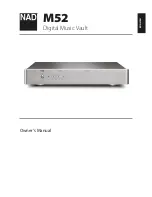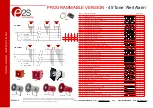
7. MAINTENANCE OF TRACEABILITY AND RECALIBRATION
Page 139
© 2005 DH Instruments, Inc.
<Exercise
Pressure>
: Box checked to exercise RPM4 monitor before
running validation.
<Test Point Unit>
: user preference (unit of measure of values in points array).
<Hold Limit >
: 0.001 kPa or equivalent
<Dwell
Time>
: Timed 45
<s>
: (Time to dwell at each point before taking
data, selecting
<manual>
dwells until the operator presses
[ENTER]
)
<Averaging Time [s]>
: 30 (Time over which data from the PG and FPG is
acquired and averaged at each validation point)
<Readings
Per
Point>
: 3 (Individual readings for specified averaging time at
each validation point)
<Validation
cycles>
: 1 (Number of times the sequence of pressure points in
the point array wil be executed. Each cycle results in a separate report)
<Validation points array>
: 10, 11, 12, 13, 14, 15 kPa or equivalent.
When the form is completed as desired, press
[Continue]
.
If the
<Exercise Pressure>
box was checked in the
[Validation Setup]
form, the
[Pressure Exersize Setup]
form appears (see Section 4.2.5). The
default values of
<Min>
,
<Max>
,
<Dwell>
and
<Cycles>
are 0, 15 kPa (max
validation pressure), 120 seconds and 3.
The validation process begins.
ADCS Tools
controls the process, stepping
through the points. Watch the
ADCS Tools Status Bar
for information on
what is occuring at any given moment.
At each point, the target pressure is set by the PG7601 system onto the
RPM4 Monitor and read for the
<Averaging Time>
. An average is taken for
the number of
<Readings Per Point>
specified. The RPM4 Monitor is then
connected to the FPG8601 system and the process is repeated. The
comparison of the PG7601 and FPG8601 is calculated following ((FPG8601-
RPM4) – (PG7601 – RPM4))
After the last pressure has completed, the system remains in current
conditios and the
FPG Validation Results Form
is presented.
View results form (see Figure 60).
<PASS>
or
<FAIL>
is clearly indicated.
<PASS>
indicates that the FPG8601 pressure standard is in tolerance as verified
by comparison with the PG7601 pressure standard (see Section 7.2.3.1).
<FAIL>
indicates that the FPG8601 pressure standard may be out of
tolerance or there is a problem with another component of the ADCS-601
system. Troublshooting should be performed to determine the cause of the
failure and correct it (see Section 7.2.3.1).
The
<FPG>
panel indicates the maximum disagreement observed between
the FPG8601 and the PG7601 in the test in the current pressure unit of
measure (FPG8601 reading – PG7601 reading) and in PPM ((FPG8601
reading – PG7601 reading)/PG7601 reading) 1000000).
The
<RPM4>
panel indicates the maximum disagreement observed between
the RPM4 Pressure Monitor and the PG7601 in the test in the current
pressure unit of measure (RPM4 reading – PG7601 reading) Pressing the
[Adjust RPM4]
button will cause the RPM4 calibration coefficients to be
adjusted to fit its readings with the PG7601 over the range of the
comparison. Note: Since the RPM4 is used only as a comparator in the test
process, its absolute agreement with the PG7601 is not significant.
Summary of Contents for ADCS-601
Page 10: ...ADCS 601 OPERATION AND MAINTENANCE MANUAL 2005 DH Instruments Inc Page VIII N NO OT TE ES S ...
Page 12: ...ADCS 601 OPERATION AND MAINTENANCE MANUAL 2005 DH Instruments Inc Page X N NO OT TE ES S ...
Page 19: ...2 SYSTEM OVERVIEW Page 7 2005 DH Instruments Inc Figure 2 ADCS 601 system pneumatic schematic ...
Page 114: ...ADCS 601 OPERATION AND MAINTENANCE MANUAL 2005 DH Instruments Inc Page 102 N NO OT TE ES S ...
Page 116: ...ADCS 601 OPERATION AND MAINTENANCE MANUAL 2005 DH Instruments Inc Page 104 N NO OT TE ES S ...
Page 146: ...ADCS 601 OPERATION AND MAINTENANCE MANUAL 2005 DH Instruments Inc Page 134 N NO OT TE ES S ...
Page 168: ...ADCS 601 OPERATION AND MAINTENANCE MANUAL 2005 DH Instruments Inc Page 156 N NO OT TE ES S ...
Page 174: ...ADCS 601 OPERATION AND MAINTENANCE MANUAL 2005 DH Instruments Inc Page 162 N NO OT TE ES S ...
















































